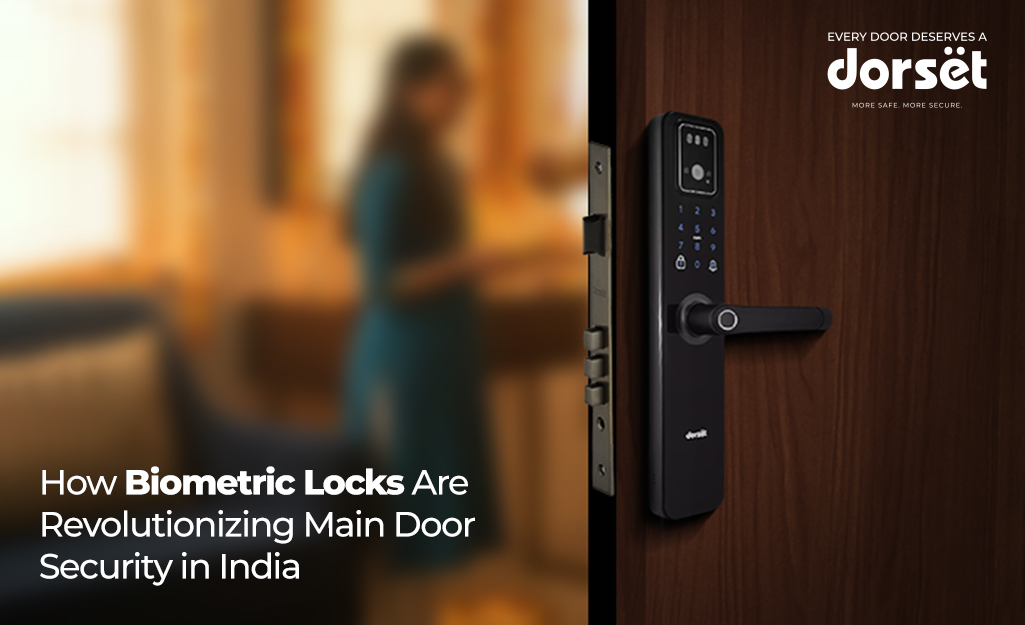
Your fingerprint is more unique than any key ever made. No two people share the same pattern, not even identical twins. This simple fact has changed door lock technology. Biometric door locks have moved from corporate offices and luxury apartments into normal homes. What was once science fiction is now a practical solution to everyday security challenges.
Why India Needed Biometric Locks
Traditional locks come with predictable problems: keys get lost or duplicated, domestic help changes, and joint families end up with dozens of keys in circulation. This creates inconvenience and potential security gaps. Reliance on guards or watchmen also leaves access dependent on human availability, which isn’t always reliable.
A biometric lock solves these problems. Your fingerprint can’t be lost or duplicated easily, and access can be granted to multiple people without physical keys. For households juggling aging parents, children, and domestic staff, this technology offers real value.
How Biometric Door Locks Work
Biometric locks use sensors to scan your fingerprint. These sensors map your unique ridge patterns and convert them into encrypted digital templates stored in the lock’s memory. When you place your finger on the sensor, it scans again and compares the template to the stored data. If there’s a match, the door unlocks often in less than a second. Modern models store between 50 and 200 fingerprints, allowing access for large households.
Other than the fingerprint, some of our models, like the Dorset DG 205 also unlocks with another biometric, which is your face through 3D face recognition. Advanced sensors, like the 360-degree readers in the Dorset DG 406, work reliably even in Indian conditions damp fingers during monsoon or dusty environments.
Why Adoption Is Growing in India
Several factors drive the rapid uptake of biometric locks in India:
- Urbanisation: More gated communities and high-rise apartments mean traditional security feels inadequate.
- Changing lifestyles: Nuclear families and working parents often have kids that are home alone. Biometric access is an easy solution without the worry of lost physical keys or forgotten codes.
- Tech-savvy population: Millennials and Gen Z value convenience and see a fingerprint door lock as a natural upgrade.
Security Advantages Over Traditional Locks
Traditional locks can be picked, bumped, or duplicated without evidence. Biometric locks eliminate most of these vulnerabilities:
- No duplicates: Fingerprints can’t be copied easily.
- No picking: No mechanical lock mechanism to manipulate.
- Audit trail: Every entry attempt is logged, giving homeowners clear visibility of who entered and when.
Adapting to Indian Conditions
Biometric locks in India face unique environmental challenges:
- Climate extremes: Humidity, heat, and dust can affect sensors. Quality locks include moisture-resistant coatings and dust protection.
- Power reliability: Locks operate on batteries, making them immune to power cuts. Low-battery alerts and emergency power options are standard in quality models.
- Durability: Locks are designed for Indian conditions, ensuring reliability during monsoons or in dusty climates.
Models like the Dorset DG 206 even combine biometric access with surveillance features, blending security with environmental adaptability.
The Cost Factor: Investment vs Value
Biometric locks cost more upfront depending on features, the cost can be significant. But consider the lifetime value:
- Traditional locks require rekeying, replacements, or locksmith calls when keys are lost.
- Biometric locks remove recurring costs, requiring only occasional battery replacements.
Over time, the higher initial investment is offset by convenience, security, and reduced maintenance. For many, the peace of mind never worrying about lost keys and knowing who enters your home justifies the cost.
Overcoming Hesitations
Concerns about biometric locks include:
- Technology failure: Modern locks include multiple backups like mechanical keys, passwords, and card access.
- Recognition issues: Current sensors offer 99%+ accuracy and work reliably under real-life conditions.
- Privacy concerns: Dorset locks store encrypted templates locally, not in the cloud. These cannot be reconstructed into fingerprints.
- Installation worries: Most models fit standard door mounts, and many households install them easily themselves. Professional installation remains an option for optimal performance.
The Future of Biometric Security in India
Currently, biometric locks are in fewer than 5% of Indian homes, but adoption is accelerating. Trends include:
- Multi-modal systems combining fingerprint, facial, or palm-vein recognition.
- Integration with smart home systems for automation.
- Adoption in rental properties and co-living spaces for easy, auditable access management.
Government smart city initiatives will also boost adoption, embedding biometric access as a standard feature in new developments.
Making the Transition
If you’re considering upgrading to a digital lock for main door, start by assessing your needs:
- How many people need access?
- Do you need remote monitoring?
- Is integration with existing smart home devices important?
Choose biometric lock models with multiple backup methods, reliable warranty, and strong customer support. Professional installation may save headaches and ensure optimum performance. Test your lock fully during the initial days to ensure smooth operation.
The Verdict
Biometric locks aren’t a luxury anymore, they’re a practical evolution of home security in India. They solve real problems: lost keys, shared access, and household security gaps. The technology is becoming affordable, reliable, and tailored to Indian conditions.
Your main door is more than just an entry point. It’s the first line of defence for your home. Upgrading it with biometric security is not extravagance, it’s a sensible, lasting investment.
Check out the full Dorset biometric lock range today!